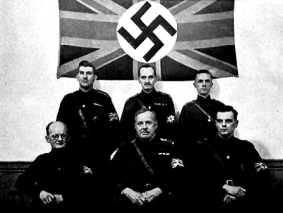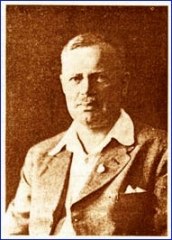Not many people in Surrey know that the town of Guildford in the heart of the county was home to one of Britain’s most notorious anti-Semites of the interwar period. During the 1930s, the fascist ideologue and racist activist Arnold Spencer Leese (1878-1956), a former camel vet, lived in what he named the ‘White House’ on Pewley Hill, a quiet and steep road not far from the centre of the town.

Leese (pictured), along with two others, had founded the Imperial Fascist League (IFL) in 1928, an organisation that he came to dominate by 1930, and which eventually took a very pro-Hitler stance, proudly displaying the Nazi swastika on all its publications, flags and insignia.
In 1932, when Sir Oswald Mosley formed the British Union of Fascists (BUF), a much larger fascist party, Leese refused all offers to join the BUF, believing that Mosley’s movement was not serious about the ‘Jewish Menace’. Leese was adamant that the IFL should remain pure in its adherence to what he called ‘real’ fascism. This doctrine placed ‘race’ at the centre of all politics, and was very much modeled on the German National Socialist creed, which was markedly anti-Semitic and obsessed with biological racism.
Tellingly, Leese even advocated mass extermination of Jews by ‘lethal’ chambers as early as 1934, and he was certainly viewed with favour by some of the leading racists in the Nazi regime.
Leese and Surrey
After he retired from running a small private practice as a veterinary surgeon in Lincolnshire in the 1920s, Leese had moved down to Guildford and set up home. However, far from settling down to enjoy retirement, Leese began to devote all his time to extreme fascist politics and to his Imperial Fascist League, with his house doubling-up as the local HQ of the IFL, with a main office in central London. He also used the White House as a place to print, store and distribute many of the organisation’s leaflets and pamphlets, and it served as a base of operations when he ventured into local political activity in Guildford.
In fact, as well as targeting Guildford with his propaganda, Leese was eager to make use of various small towns and their localities across Surrey, organising a number of debates under the auspices of the IFL. Such meetings had the added benefit for Leese of generating news coverage and publicity in the local Surrey press. A good example of this occurred in the Surrey village of Great Bookham in November, 1930, when Leese engaged in a debate with representatives of the League of Nations Union (LNU). Leese loathed the League of Nations, claiming at the meeting that it was under ‘Jewish control’.
Similarly, Leese and his IFL activists made sure they attended meetings of local organisations they especially disliked, where they could try to hi-jack the Questions and Answers session that often concluded such public meetings. A typical example of this occurred in September, 1931, when a new branch of the Friends of the Soviet Union was launched in Guildford and held its first meeting. This was like a red rag to a bull as far as Leese was concerned. As one Guildford newspaper reported, there was ‘a good deal of opposition from an anti-Jewish element in the audience’, and – at one point – Leese declared to the attendees that ‘Jewish international finance’ was running not only Russia, but also Britain.
Union Jack and Swastika

In March, 1934, Leese’s organisation gained considerable local publicity when it held its first full public meeting in the town, at the Ward Street hall in Guildford. According to one report, the ‘hall was crowded, and around the walls stood uniformed stewards of the organisation’. An arm-band consisting of a Union Jack with a swastika in the centre was worn by every IFL member who attended the meeting, and throughout the evening a fascist stood on the platform with the League’s flag – the Union Jack and swastika – while Leese spoke. Leese delivered a lengthy speech on the history of ‘Jewish money power’. Interestingly, he also caused controversy by suggesting that the majority of people in Guildford were ‘a comfortable crowd’ and were ‘slow to wake up’, but he appealed to them for ‘a little unselfishness’ so that they might come forward and become involved with fascism.
Leese added that ‘Finance’ had, in his view, ‘been used as a Jewish tool to bring the country down to where it was now’. Towards the end of the meeting, Leese also told the audience that he was ‘perfectly prepared’ to open and shut the lethal chamber door ‘all day if they could get rid of the Jews that way’, but he did not think the people of England would stand for it.
Possibly the high-point of publicity for Leese in Guildford occurred during the 1935 General Election. Leese temporarily lit up the election campaign in the town when he made the surprise announcement that he would stand as a fascist parliamentary candidate in the Guildford parliamentary division. This gained him a rare full interview in the local press, which he used to argue that, if he was elected, it would ‘at least give a chance for Fascism to be thoroughly examined, whereas at the present it is simply the subject of hostile criticism from alien sources which control much of our daily press’.

He also used the interview as an opportunity to take swipes at democracy and assert that the hope of the world depended on the ‘Aryan’ race. Predictably, just one week later, Leese announced his withdrawal from the election, alleging that it was an ‘unfair contest’ and it would be a waste of his cash resources if he carried on with his campaign.
When war broke out in September, 1939, Leese’s IFL (as with Mosley’s BUF and other fascist groups), continued to function, pursuing an anti-war line. Leese published a pamphlet entitled Leese for Peace, in which he claimed that the war was being fought by Britain at the behest of ‘Jewish Interests’. In May, 1940, with growing fears that Britain might be invaded by the Nazis, the government decided to arrest many leading fascists under new Defence Regulations.
To avoid detention, Leese went on the run, staying in a series of hideouts. He also made occasional secret visits back to Pewley Hill, where his equally racist wife, Mrs. May Leese, would supply him with food and fresh provisions. However, the police Special Branch kept a close watch on the house, and Leese was finally caught and arrested in November, 1940.
Post-war Obsessions
One suspects that nearby residents in Guildford must have been very pleased to hear the news of his capture. On the other hand, they must have been very disappointed when Leese was released from prison in 1944 and immediately returned back to Guildford. Shockingly, within just weeks of the end of the war, Leese was quickly back to his former activities.
He used his Pewley Hill home to launch a new anti-Semitic monthly entitled Gothic Ripples, and to self-publish and distribute a book called The Jewish War of Survival, a racist diatribe which defended Hitler’s wartime actions. The latter book claimed that ‘Jewish Money Power’ had been behind the war. Leese even managed to send a copy of the book to the Defence Counsel for Hermann Goering at the Nuremberg Trials (which they accepted).
Significantly, the White House also received visits from a number of early post-war British neo-Nazis, who were eager to seek out their ‘hero’ and gain his approval (his circle of fans included a young Colin Jordan), and it remained Arnold Leese’s main base of propaganda operations right up to his death in 1956.
Jordan, a rising ‘star’ of the neo-Nazi scene in Britain, was later given a London house by Mrs. Leese, not long after her husband’s death. An excellent new academic study, Failed Fuhrers: A History of Britain’s Extreme Right (Routledge Studies in Fascism and the Extreme Right, 2020), by Graham Macklin, throws some invaluable new light on this and on Leese’s general career as a leading racist.
Dr. Steven Woodbridge is Senior Lecturer in History at Kingston University, Surrey
(All images: Wikimedia Commons)
Note: A shorter version of this blog was first published here in October, 2017.


Blimey Steve, a super-fascist in Guildford!
LikeLike
Hi Nick,
Yes, Surrey has this kind of ‘secret’ history that not many people know about, really. But I feel it’s my duty as a historian to dig it all out, warts and all. Best wishes,
Steve.
LikeLike
Pingback: A Nazi in Guildford: The activities of Arnold Leese in Surrey in the 1930s – Modern British History